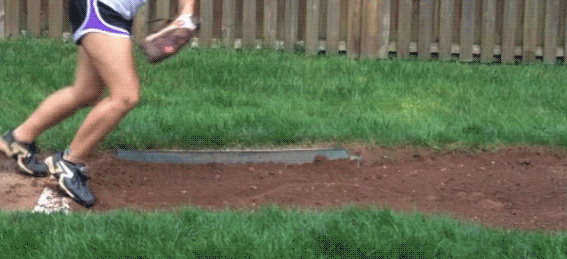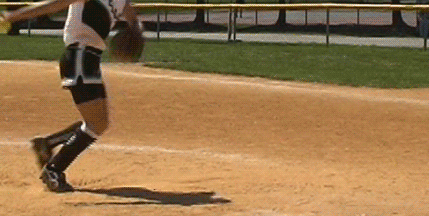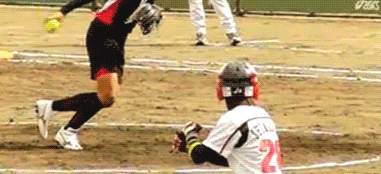Where Drive Throughs Go Wrong
Last week I talked about the phases of the drive-through and how your body moves differently in each phase. I mentioned that this is something that MANY pitchers struggle with, but if you’re one of those pitchers, you may not fully understand why. Today we’re going to look at the top cause of not executing both phases of the drive-through.
What lack of hip stability does to your drive-through
In order to smoothly complete both phases of the drive-through, your knee needs to power your leg forward in phase two, as discussed in the previous article. That becomes very difficult if your knee is not already pointed forward at the start of phase two. And for many many pitchers, it’s not.
What happens when you lack adequate natural hip stability (which is almost every young female pitcher) is that when you open from forward to sideways into K position, EVERYTHING, including your knee and foot, opens to the side:

This is a phase one with a very good push off, but you’ll notice that the knee is affected by the turn into K position enough to cause the pitcher to end up on the side of her foot. This results in a slow drive-through that is stressful to the groin area and affects posture.
The pitcher in this example is actually rather strong and accomplished for her age. She achieves a very dynamic phase one despite the knee and foot position. Many pitchers with the same problem will have MORE trouble with phase one, leaving the drive foot back by the rubber until after the landing, or illegally breaking contact with the ground as the knee turns.
Take a look at these examples of better phase one knee position:


These were clipped from our previous slow-motion pitcher animations. The first is Coach Jill of Fastpitch Power, and the second is Yukiko Ueno. Notice that as their bodies turn into K position, their knees are not drastically affected. Ueno’s turns out very slightly, but not enough to affect her foot and not enough that she can’t very easily get back into her knee-forward position to begin phase two.
How do you fix this?
As I mentioned above, this is caused by lack of hip stability. You need tremendous hip stability in order to turn your body one way and maintain your original orientation with your support leg.
I hear a lot of parents and coaches getting frustrated with their pitchers for not concentrating hard enough to keep their knees forward after I tell them to do so. I can’t stress this enough: this is likely not a matter of concentration. It’s a matter of physical deficiency that needs to be corrected OUTSIDE of pitching practice before it can be fixed in pitching. In short, WORK OUT. Or else this might be impossible forever.
Take a look at my compiled resources for addressing leg strength issues that contribute to poor drive-through. Consider adding a strength routine to your practice if you haven’t already.
Carly, what exercises would you suggest to increase hip stability? I was a pitcher very young, and continued into college and now coach. I am experience cing many physiological issues associated with what I term incomplete fitness as a young pitcher. Our coaches are generally volunteers who take on the task in order to provide youth opportunities to play. Unfortunately, these coaches don’t know the first thing about complete training.
I’d like to share some work-out options with my girls that will balance them and avoid injury through increased strength and flexibility.
Thank you.
Hi Rushel,
I’m so glad you’re interested in incorporating strength training into your coaching! Take a look at the last link in the article above for some videos with exercises that address hip stability. Then if you click on Joe’s name and browse his posts, you’ll find a lot more total body exercises as well.
Do you have any drills that might help correct this? My daughter has a drag foot issue and now looking at the video, I am wondering if this may be the reason. She is in great shape (multi-athlete) and I don’t think it’s a matter of leg strength. She is pretty athletic and strong. I have a video if you would like to review.
Thanks for any help!
Nicole – being a multi-sport athlete will not necessarily give your daughter the structural balance and strength to avoid this particular problem. An evaluation by a qualified strength and conditioning professional is, in my opinion, an essential component of any serious athletes training. Her legs may be strong but her hips and glutes may not be. It may also be a result of developing the mechanical flaw over a long period of time when she was young and performing the movement without anyone to correct her. You do not mention how old your daughter is but the older an athlete is, generally speaking, the more difficult it becomes to break bad habits. If the video is not too long, you may e-mail me at; phil@fastpitchpower.com. I will be happy to review it and give you my opinion.